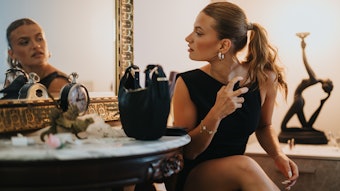Editor’s note: This is an edited version of an article that originally ran in the January/February 2014 issue of Cosmetics & Toiletries magazine. Reprinted with permission, and all rights reserved.
Lipstick is arguably the most enduring of cosmetic products. Both women and men have colored their lips at various times throughout the ages, though the practice fell in and out of favor, changing with society’s value judgments. As lip-painting fluctuated in popularity, it manifested itself as a reflection of the modesty, moral austerity and/or accepted social norms of a particular era.1
Despite its sometimes negative associations, the act of coloring lips has persisted. The use of lip color has signified many different things, not all necessarily related to aesthetic enhancement. For example, coloring lips has historically represented social status2 and been used as a form of protest to signify emancipation.3 More recently, women have used it to capture the glamour of Hollywood for themselves, or quite simply to enhance their natural lip color and boost their mood. Conversely, lipstick sales have also been linked to a downturn in world economies, and as such, acts as a barometer of the mood of the people.4
Lipstick performs as much more than a cosmetic: it is an emblem, a tool of ritual, and a marker for expression, seduction and femininity.
Formulation and Development
The most striking element of any lipstick is, without a doubt, the color—and red lipstick is especially iconic today. Cleopatra is perhaps one of the most notable figures from historical times who reputedly added color to her lips using crushed cochineal beetles to extract the red carmine color.5 It also is reported that before Cleopatra, more than 5,000 years ago, Egyptians stained their lips using ochre and iodine.6 From this and other early forays into makeup application, the world’s obsession for applying lip color began.
Since these first, crude methods of production, lipstick has thankfully become much more sophisticated. In today’s world, consumers expect lipstick to go beyond color application, and women’s minimum expectations for performance appear to increase with each passing decade—mirrored with the need for beauty companies to constantly deliver on brand promises and product performance claims, and to provide stand-out-from-the-crowd effects. The lipsticks of today are still recognizable descendents of the mass-produced formulations that began in the mid-twentieth century and consist, for the most part, of waxes, oils, alcohol and pigments. During lipstick’s development, the industry has witnessed a number of evolutionary cycles, but the core formula type has remained fairly constant, and each of the ingredients plays an important part in the structural and aesthetic qualities of a lipstick.
For example, commonly used waxes such as beeswax, carnauba and candellila give substance and form to the final product. Therefore, balancing the correct wax blend is an important consideration for the product development. The melting point of waxes impacts the softness of the end product; low-melting point waxes may render a softer stick that is difficult to contain within its pack and makes application messy and uncontrollable. A texture that is too hard can result in a difficult and unpleasant application with a poor sensorial experience.
Lipstick Packaging
The well-known metal lipstick tube was born in 1915, first manufactured by Guerlain;7 prior to this, commercial lipsticks were wrapped in paper and sold in jars, pots or paper tubes. Two Americans are credited with developing this modern tubed pack. Maurice Levy invented the first metal dispenser that encased the lipstick bullet, and the pack had levers on the side to raise and lower the stick. James Bruce Mason, Jr., patented the swivel-up lipstick that remains a staple of the industry today.8
In lipstick’s history, these two notable advances paved the way for the mass manufacture and distribution of lipstick. Lipstick had become compact, accessible to those who could afford it and a portable item ideal for a lady’s purse.
Gaining Acceptance
Following advances in packaging, an array of flavors, shades and concepts in lipstick came onto the market—including those having long-wear properties and deodorizing effects, which increased the propensity for lipstick use. Mass manufacture, women in the workforce and greater disposable income—along with the rise of consumerism, magazines and movies—all helped contribute to a shift in attitude toward cosmetics. Ultimately, this meant cosmetic companies’ advertising campaigns could engage with a wider audience, and product sales were able to first flourish then grow exponentially.9
Long-wear Concepts
In today’s market, long-wearing lipstick concepts permeate. As reviewing recent commercial launches reveals, wear is an integral part of lipstick’s key attributes, and the ability for it to last is a key consideration for formulators and marketers alike. For example, D&C Red 21, a commonly used red fluorescent dye, is one raw material used to create effective, lasting color. This dye combines with moisture on the skin, staining the lips so that color remains even after the product has worn off. Also, water-insoluble dyes or bromo acid dyes such as D&C Red 21, D&C Red 27 and D&C Orange 5 have been used since the 1920s to deliver blue-red and orange-red shades.10,11
In the early twentieth century, chemist Hazel Bishop recognized a key consumer need and addressed it when she created a lipstick claiming to be “kiss-proof.”12 The advertising campaign at the time, “It stays on you, not on him,” captured very succinctly one of the biggest problems being encountered: transfer of the product from the lips. Bishop’s attempts at developing a true long-lasting product were not without setbacks, however. Long-wearing formulas tended to dry out the lips, and this obstacle has persisted as a challenge to formulators yet today. Bishop’s lipstick incorporated dyes for staining purposes in addition to pigments, which adhered firmly to the lips to achieve lasting wear while offering a richer, more substantive lip appearance.11
Bishop’s attempts almost a century ago exemplify a concern that is still relevant today: the comfort factor. Product developers can be forgiven for believing that wear and comfort in a lip product are mutually exclusive; no sooner does one create a smooth, silky feel, then the wear is affected—and vice versa. In fact, so much so that creating a dual-ended product can be a very elegant solution to this formulation conundrum, and examples of this are common on the market today.
Product developers have also turned to solvent-based ingredients to create longer-lasting lipstick. Isododecane is a solvent that can be used to help reduce product transfer. This volatile, synthetic substance flashes off on contact with the skin, binding the colorants to the lip as well as creating a lightweight and matte finish. Its very characteristics—i.e., volatile nature and lower flash point—make isododecane an excellent solvent and dispersion agent, allowing it to extend lipstick wear; however, these can also render the manufacture process more challenging.
Added Benefits
Aside from extending lipstick wear, treating pigments with coatings can contribute further benefits. For example, alkyl silicone can enhance wear, increase compatibility with other raw materials and improve skin feel. Isopropyl titanium triisostearate delivers similar benefits but also improves the compatibility with oils in the formulation. This aspect, in particular, allows for more pigment loading for higher color coverage and, therefore, enhances wear properties. Treating pigments with amino acids also improves skin adhesion and produces better coverage while enhancing softness and comfort.
Future Outlook
What is in the future for wear and color effects in lipsticks? Trimethylsiloxysilicate (TMS) has great potential for enhancing wear, delivering a glossy effect and increasing adherence to the lips. TMS is a highly cross-linked silicone resin that functions as a film-former. Its net-like structure and adhesive properties means it holds pigments in place, displays water-resistance and improves wear.
Also on the global market, new molecules are evolving that modify the compatibility of lipstick with raw materials to provide more affinity with skin and improve the transfer-resistance. One such example is polyphenylsilsesquioxane—a hybrid between silicone elastomers and TMS resin.
Pigment encapsulation is another potential route for extending lipstick wear; however, not all capsules are suitable for hot-pour products. A high-functioning encapsulation system that could withstand heat would additionally allow a broader choice of actives to increase lipstick performance. Entrapment platforms using polyurethane as a base are commonly referred to as “encapsulation,” but true encapsulation, such as those that provide the means for flavor delivery, are technologies based on hydrolyzed corn starch and hydrated silica. There is perhaps potential in this arena to bring performance results from a pigment and flavor perspective.
Conclusions
While wear appears to be the core performance aspect of lipsticks, it is not the only consideration. The lines between skin care and color cosmetics are increasingly being blurred, and multifunctional and hybrid cosmetic concepts are in demand. There is increasing consumer demand to achieve the best results possible in the quickest, easiest way. This makes the role of a beauty industry product developer and formulator not only more challenging but also more intriguing as they seek the latest technologies that drive innovative products.
References
- pubs.acs.org/cen/whatstuff/stuff/7728scit2.html (Accessed Nov 18, 2013)
- dash.harvard.edu/bitstream/handle/1/10018966/Schaffer06.html (Accessed Nov 18, 2013)
- Ibid Ref 2
- www.economist.com/node/12995765 (Accessed Nov 18, 2013)
- tribune.com.pk/story/321528/carrying-on-cleopatras-legacy (Accessed Nov 18, 2013)
- J Gabriel, Holistic Beauty from the Inside Out: Your Complete Guide to Natural Health, Nutrition and Skincare, 1st edn, Seven Stories Press, New York (2013)
- www.guerlain-makeup.com/en/make-story/color-red (Accessed Nov 18, 2013)
- M Madeleine, History of Compacts and Cosmetics: From Victorian Times to the Present Day (Women with Style), Edition: Remember When (2010) p 113
- J Willett, Cosmetics, in The American Beauty Industry Encyclopedia, Greenwood Press, San Francisco (2010) p 71
- www.cosmeticsandskin.com/cdc/indelible.php (Accessed Dec 10, 2013)
- www.cosmeticsandskin.com/companies/hazel-bishop.php (Accessed Nov 15, 2013)
- V Sherrow, For Appearances’ Sake: The Historical Encyclopedia of Good Looks, Beauty and Grooming, Greenwood, Phoenix, Ariz. (2007) pp 48-49
Rachel Mallon, Nunzio Ripamonti and Natasha Williams O’Hanlon, PhD work for Oriflame Research and Development Ltd. in Bray, Ireland.










